Scientists have determined that the earth was born about 4.5 billion years ago, and it seems life began to start not long after that. The Early Planet was a harsh place which could not contain the life we know today. An important element required for all the earth's organisms is carbon, and in light of this, Earth had to have rich supply of carbon to support our rich diversity of life. This carbon was made available by the volatile nature of the Earth in the beginning, when volcanoes spewed various elements into the Earth's atmosphere. Young earth also needed amino acids, which are the building block of proteins, and thereafter the building blocks of life. In general, organisms over time in the evolutionary chain have grown and become more complex in their nature. The first life was likely small, simple and not diversified.
One understanding of the origins of life is that it would have been very unlikely that parasites were the beginnings of life. As parasites require biological hosts to reproduce and thus survive as a species, they would have been unable to successfully continue their species during this time period. In light of this, viruses and other parasites would have developed later on in the evolutionary chain.
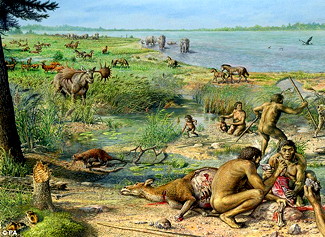 Prehistoric life: Archeologists and historians have suggested that the first human beings lived in caves along the southern coast of Africa. The region had a warm climate and provided plenty of food for them. Human evolution began when our species became distinct from other hominids and great apes, and developed through millions of years into Homo sapiens. Homo sapiens have a long history on our planet; something between 100,000 years and 500,000 years. The term human in the context of human evolution refers to the genus Homo, but studies of human evolution usually include other hominids. Many now propose that chimpanzees and humans have a common ancestor. Then populations of that common ancestor became isolated from each other, and evolved into different species over time, through "natural selection" of individuals. At present we know very little about this elusive theorized "common ancestor." Lets look at early animals and then the prehistoric human.
Prehistoric life: Archeologists and historians have suggested that the first human beings lived in caves along the southern coast of Africa. The region had a warm climate and provided plenty of food for them. Human evolution began when our species became distinct from other hominids and great apes, and developed through millions of years into Homo sapiens. Homo sapiens have a long history on our planet; something between 100,000 years and 500,000 years. The term human in the context of human evolution refers to the genus Homo, but studies of human evolution usually include other hominids. Many now propose that chimpanzees and humans have a common ancestor. Then populations of that common ancestor became isolated from each other, and evolved into different species over time, through "natural selection" of individuals. At present we know very little about this elusive theorized "common ancestor." Lets look at early animals and then the prehistoric human.
The Early Animals:
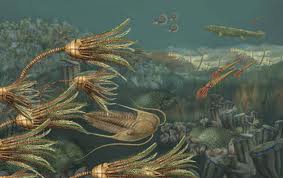 Plant and Animal Evolution: For most of the Earth’s history, life was restricted to the sea. Since about 600 million years ago, plants and animals have developed into complex mulit-cellular organisms and diversified into a wide variety of species. Animals have taken the major step from from living in water to also occupying land ecosystems. Using new high-powered technologies for analyzing massive volumes of genetic data, studies have revealed the earliest splits at the base of the animal tree of life. The tree of life is a hierarchical representation of the evolutionary relationships between species that was introduced by Charles Darwin. Early Animal Evolution: Emerging Views from Comparative Biology and Geology. The first animals on Earth were significantly more complex than previously believed. Of interest to us in examining our origins is The Evolution of Mammals.
Plant and Animal Evolution: For most of the Earth’s history, life was restricted to the sea. Since about 600 million years ago, plants and animals have developed into complex mulit-cellular organisms and diversified into a wide variety of species. Animals have taken the major step from from living in water to also occupying land ecosystems. Using new high-powered technologies for analyzing massive volumes of genetic data, studies have revealed the earliest splits at the base of the animal tree of life. The tree of life is a hierarchical representation of the evolutionary relationships between species that was introduced by Charles Darwin. Early Animal Evolution: Emerging Views from Comparative Biology and Geology. The first animals on Earth were significantly more complex than previously believed. Of interest to us in examining our origins is The Evolution of Mammals.
Early Human or Prehistoric Human:
|
Homo Habilis is a well-known, but poorly defined species. The specimen that led to its naming was discovered in 1960, by the Leakey team in Olduvai Gorge, Tanzania. This specimen and its designation was the subject of much controversy up through the 1970s. The material was found in the same region where A. boisei had previously been found, and many researchers of the time did not fully accept that the new material was sufficiently different to denote a new species. |
|
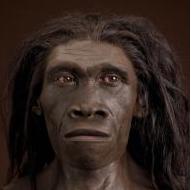 Homo erectus It is widely accepted that a population similar to Homo erectus was directly ancestral to the earliest members of Homo sapiens. The exact timing and mode of transformation are still controversial. Homo erectus It is widely accepted that a population similar to Homo erectus was directly ancestral to the earliest members of Homo sapiens. The exact timing and mode of transformation are still controversial. Throughout the early years of paleoanthropology, there were only two different species that were attributed to the genus Homo. These included the Neanderthals, and Homo erectus. In the early 1960s, this began to change, and human ancestry seemed to be populated by many different players. Accordingly, erectus is one of the better-known members of genus Homo, especially in terms of its well-established place in paleoanthropology. This has begun to change, however, and now some question its place in human evolution. |
|
|
Today |

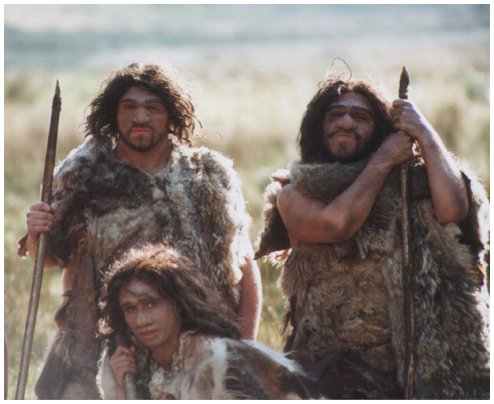
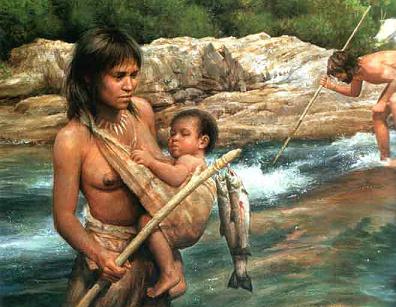
 We have come a long way from the life of prehistoric humans; we have adapted and survived in our journey, and homo sapiens is written in the language of our genes within every cell of our bodies—as well as in the fossil and behavioral evidence. Today we are proud of our advanced cities with beautiful architectures. We are proud of our advance technology, social media, and content sharing where we know what is going on across the world. However: We have polluted our air, We have polluted our lands, We have polluted our water, We have destroyed our forests, We do not respect human rights, We are greedy and we do not care how we get what we want. We have child soldiers, we have child labour, we have child trafficking, we have human trafficking, we permit all kinds of atrocities happening around the world as long as they don't bother us. We close our eyes and cover our ears and get busy with our daily work and save for our fun and our vacations, no matter the cost to the Earth. How intelligent is that?
We have come a long way from the life of prehistoric humans; we have adapted and survived in our journey, and homo sapiens is written in the language of our genes within every cell of our bodies—as well as in the fossil and behavioral evidence. Today we are proud of our advanced cities with beautiful architectures. We are proud of our advance technology, social media, and content sharing where we know what is going on across the world. However: We have polluted our air, We have polluted our lands, We have polluted our water, We have destroyed our forests, We do not respect human rights, We are greedy and we do not care how we get what we want. We have child soldiers, we have child labour, we have child trafficking, we have human trafficking, we permit all kinds of atrocities happening around the world as long as they don't bother us. We close our eyes and cover our ears and get busy with our daily work and save for our fun and our vacations, no matter the cost to the Earth. How intelligent is that?